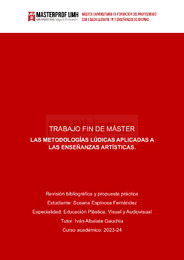Por favor, use este identificador para citar o enlazar este ítem:
https://hdl.handle.net/11000/32888Registro completo de metadatos
| Campo DC | Valor | Lengua/Idioma |
|---|---|---|
| dc.contributor.advisor | Albalate, Iván | - |
| dc.contributor.author | Espinosa Fernández, Susana | - |
| dc.date.accessioned | 2024-08-02T12:04:29Z | - |
| dc.date.available | 2024-08-02T12:04:29Z | - |
| dc.date.created | 2024-06 | - |
| dc.identifier.uri | https://hdl.handle.net/11000/32888 | - |
| dc.description | Especialidad: Educación plástica, visual y audiovisual | es_ES |
| dc.description.abstract | Ante la predisposición negativa de gran parte del alumnado a la idea de crear y expresar en las materias artísticas obligatorias, es necesario crear propuestas didácticas que motiven al alumnado a participar activamente en el proceso de creación. Por eso, el principal objetivo de este trabajo es comprender y evaluar los beneficios de las metodologías lúdicas en la materia de Educación Plástica Visual y Audiovisual -EPVA-. Las metodologías lúdicas, la utilización de juegos como recursos de aprendizaje, suponen una experiencia educativa positiva por motivar al alumnado, dinamizar la clase, promover el aprendizaje activo, potenciar la creatividad y la imaginación y fomentar las habilidades sociales; entre otros. Arte y juego son una combinación eficaz, gratificante y estimulante, aprovechable en el desarrollo y la educación integral del individuo. Por este motivo, se proponen 4 situaciones de aprendizaje en las que se utilizan la Gamificación y el Aprendizaje Basado en el Juego para la materia de EPVA. | es_ES |
| dc.description.abstract | Given the negative predisposition of a large part of students to the idea of creating and expressing in compulsory artistic subjects, it is necessary to create didactic proposals that motivate students to actively participate in the creative process. For this reason, the main objective of this work is to understand and evaluate the benefits of playful methodologies in the subject of Visual and Audiovisual Arts Education. Playful methodologies, the use of games as learning resources, are a positive educational experience because they motivate students, make the class more dynamic, promote active learning, enhance creativity and imagination and foster social skills, among others. Art and play are an effective, gratifying and stimulating combination that can be used in the development and integral education of the individual. For this reason, 4 learning situations in which Gamification and Game-based Learning are used are proposed for the Visual and Audiovisual Arts Education subject | es_ES |
| dc.format | application/pdf | es_ES |
| dc.format.extent | 33 | es_ES |
| dc.language.iso | spa | es_ES |
| dc.publisher | Universidad Miguel Hernández | es_ES |
| dc.rights | info:eu-repo/semantics/openAccess | es_ES |
| dc.rights.uri | http://creativecommons.org/licenses/by-nc-nd/4.0/ | * |
| dc.subject | Metodologías lúdicas | es_ES |
| dc.subject | Aprendizaje basado en juegos | es_ES |
| dc.subject | Gamificación | es_ES |
| dc.subject | Enseñanzas artísticas | es_ES |
| dc.subject | Motivación | es_ES |
| dc.subject | Creatividad | es_ES |
| dc.subject.other | CDU::3 - Ciencias sociales::37 - Educación. Enseñanza. Formación. Tiempo libre | es_ES |
| dc.title | Las metodologías lúdicas aplicadas a las enseñanzas artísticas | es_ES |
| dc.type | info:eu-repo/semantics/masterThesis | es_ES |

Ver/Abrir:
TFM Espinosa Fernández, Susana.pdf
565,35 kB
Adobe PDF
Compartir:
 La licencia se describe como: Atribución-NonComercial-NoDerivada 4.0 Internacional.
La licencia se describe como: Atribución-NonComercial-NoDerivada 4.0 Internacional.
.png)